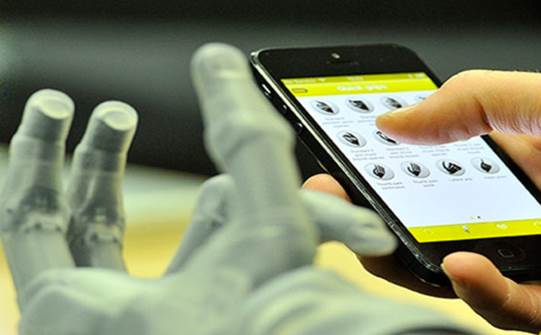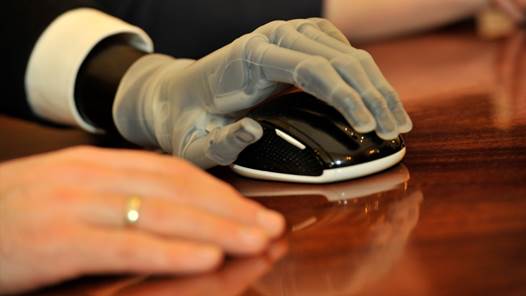Your iPhone can do anything? Now it
can program bionic hands…
As a certain time-honored advertising
campaign so famously said: “There’s an app for that” – and of course, it’s true
that iDevices and the iOS platform that powers them have expanded so many
people’s sense of precisely what a mobile phone can be expected to do, ever
since the first iPhone’s emergence in 2007.

iOS
apps now take the form the everything from productivity-boosting word
processing and spreadsheet apps to means of making art and music
iOS apps now take the form the everything
from productivity-boosting word processing and spreadsheet apps to means of
making art and music, and there are – of course – a fair amount of games to be
found in the App Store as well. But life isn’t always a mere game, and every
now and then, something with the dizzying functionality and intuitiveness of
iOS comes to the rescue of someone who needs something infinitely more
invaluable than a mere gimmick with which to while away those hours.
Yes, iDevices may be criticized sometimes
as expensive toys, but they have also had life-changing value for some of us –
people like Jason Koger and Nicola Wilding.
How iPhones are bringing life after debilitating injury
People may joke, from time to time, that a
person is so glued to their iPhone that it’s practically an extension of their
body. For some people, that is quite literally true, but even the jollier
interpretation of the phrase has a certain kernel of truth. iDevices have long
been hailed for their incredible intuitiveness and even as you read this very
article, you’ll be dabbing various areas of the screen without a moment’s
thought, perhaps switching from one app to another as you do.

People
may joke, from time to time, that a person is so glued to their iPhone that
it’s practically an extension of their body
Sometimes, people use styluses on their
iDevices, although many simply use their fingers – but have you ever stopped to
think just how big an effect it would have on your user experience if neither
were an option for you? Such devices are, after all, designed around default
human bodies with their fully-functioning arms and fingers that give them the
ability to pinch, cling, glide and perform so many of the other functions that
you never gave much conscious thought to.
Part of the genius of an iDevice is that
using one is as sample and as intuitive as picking up a pen. But then again, it
really is the case that people don’t realize what they have until they lose it,
which is certainly something that you could say of personal mobility and
dexterity. There is a gracefulness, elegance and poise to the human digits that
many of us don’t consciously appreciate – but it would be a different story if
you suffered a debilitating injury that robbed you of the use of them.
Jason Koger’s story
In just about the worst-case scenario,
about which so many people have nightmares – the complete loss of their hands.
That was exactly what happened to the protagonist in our first story, Jason
line in 2008. After his trauma, the last thing that he could have expected was
anything approaching a return to an almost full range of motion. It would have
surely seemed still less likely to him that one of the sources of his respite
would be a smartphone app.

The
i-limb differs from standard prosthetics in its incorporation of five
individually powered fingers, including a fully-rotatable thumb
That is precisely what has transpired, with
CNN reporting that he is the first double amputee to have been fitted with
prosthetic arms that can be controlled by an iPhone app. It has to be admitted
that the arms themselves are nothing if not formidable. As a matter of fact,
the i-limb ultra – the brainchild of UK firm Touch Bionics – represents the
leading edge in prosthetic technology, with the developers describing it as the
closest thing to a real human hand. The i-limb differs from standard
prosthetics in its incorporation of five individually powered fingers,
including a fully-rotatable thumb. The wrist also rotates, while the 24 other
grip patterns that are made possible by the app mean that Koger can do things
like picking up a pen, using tools and shaking hands.
It’s all very impressive; we’re sure you’ll
agree. Jason has a less realistic-looking, claw-like “working hand” at his
disposal, and he has even customized his own grip pattern.
Most poignantly, ha has spoken of the
“gift” of being able to hold onto his daughter’s hand for the first time in
five years.
So many of us can’t to appreciate the
heightened convenience brought to the life of someone like Jason by such an
apparently simple combination as some bionic hands, an iPhone, a stylus and a
well-chosen app. Whereas it once wasn’t possible for him to adjust the grips on
his bionic hands without flying hundreds of miles to visit a clinician. Now, he
can make those changes himself with the minimum of fuss and five his life so
much more independently.